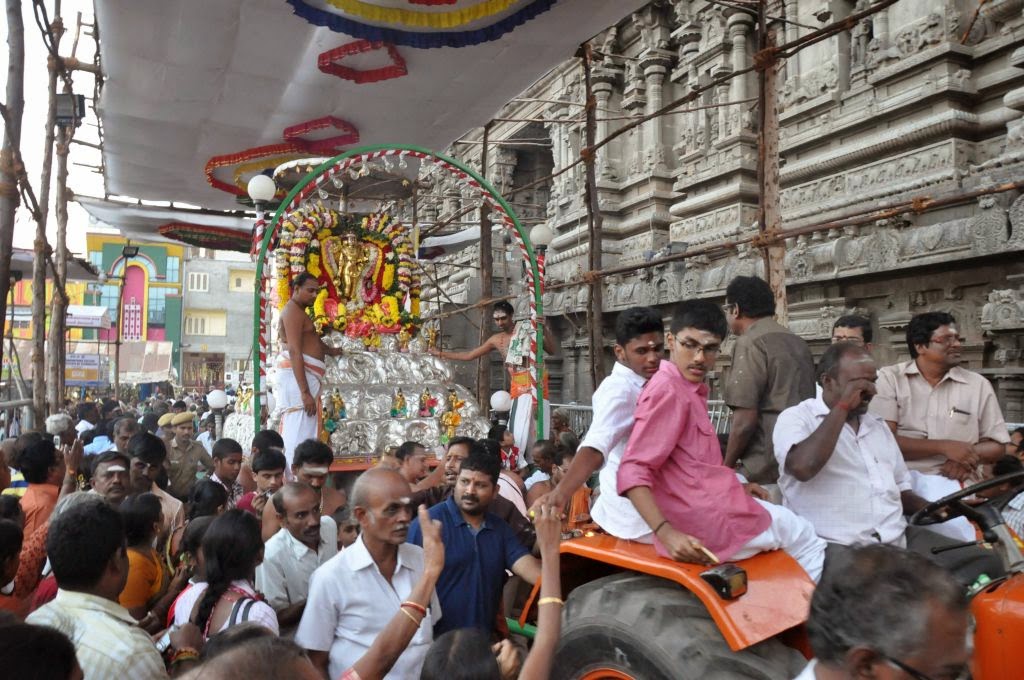Wish Fulfilling Tree and Cow
[Due to a photograph glitch, this posting on Arunachala Grace, 'Day Four—Night of the 2014 Deepam Festival', of the wish-fulfilling tree and cow is out of sequence. To be clear, however, this function did indeed occur as usual on the night of the fourth day of the Karthigai Deepam Festival]
One of the most popular of the processions during the Deepam Festival at Arunachala, is that of the Kamadhenu, the wish fulfilling cow, and the Kalpavriksha (also known as Karpavirutcham), the wish fulfilling tree. Both of which emphasis the wish fulfilling aspect of Arunachala.
 |
| Lord Karthikeya, Lord Arunachaleswarar and Goddess Saraswathi |
The Kalpavriksha is a mythological divine tree said to fulfil all desires. Its mythology narrates that the wish-fulfilling tree originates from the churning of the ocean of milk afterwhich the god Indra, returned with the tree to his paradise. During the Deepam Festival on the Fourth Night Lord Arunachaleswarar is seated under the Kapavriksha Tree.
 |
| Glorious Wish Fulfilling Tree outside Temple Mandapam |
The second major Radham appearing on that night is that of Kamadhenu (literally meaning; the cow; "from whom all that is desired is drawn", or “the divine cow providing for all needs”). The Kamadhenu is a divine cow-goddess described in mythology as the mother of all cows who provides the owner with whatever is desired.
Theories as to the origin of the Kamadhenu are two-fold. One scripture describes her as the daughter of the creator god Daksha, and another narrates that Kamadhenu also emerged from the churning of the cosmic ocean. Upon the divine cow during the Deepam night procession is seated the Goddess Saraswati.
 |
| Wish Fulfilling Tree vahana of Lord Arunachaleswarar |
It is often the wish fulfilling aspect of Girivalam that brings many pilgrims each Poornima (Full Moon) to the Hill, whatever the difficulty or weather, to perform circumambulation. In fact many pilgrims prefer it when the conditions are extreme (cold, heavy sheeting rain, previous tapas such as fasting and mortification etc) as they believe that the greater the difficulties they overcome in performing girivalam, the greater will be the focus of their sankalpa (intention) and success of their wish.
 |
| Wish Fulfilling Tree rounding the perimeter streets of Temple |
The now deceased Annamalai Swami explains the power of the Hill as thus:-
“. . . It is not an ordinary hill. It is spirituality Itself. It has a powerful, magnetic pull to the Self. Seekers who come to this place with the intention of realizing the Self will have untold benefits to do pradakshina on a full moon.
 |
| Kamadhenu -- Wish Fulfilling Cow |
In the proximity of this holy hill the presence of the Self is more powerful and more self-evident than anywhere else. Indian mythology speaks of a wish-fulfilling tree. If you find this tree and tell it what you want, your wish will be granted.
Arunachala also has this reputation. This is why so many people come here on a full moon night and walk around it. But very few people come here and ask for their complete freedom, for undisturbed peace.
Arunachala is a light. It shines. It is the light of the Self, and the light of the Self will continue to shine on you whether you believe it or not.
Arunachala is greater than all other religious places. There are other holy, powerful places in the world, but none have the power of Arunachala . . . There is a huge amount of shakti, or spiritual energy, here.”


















































